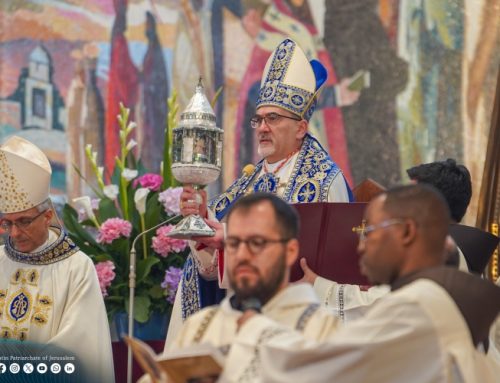Jesus and the Dead Sea Scrolls
Revealing the Jewish Roots of Christianity
By John Bergsma
The mystique of the Dead Sea Scrolls — from their discovery in the Judean desert in the 1940s to the long delay in publishing — has led to outlandish theories that can obscure the genuine reasons for their fascination. They provide the oldest surviving manuscripts of the Old Testament, proving the continuity and stability of the texts, as well as containing some manuscripts created during the lifetime of Jesus. They also illustrate the beliefs and practices of a community of Jews that developed shortly before the birth of Christ, casting new light on Judaism and the early Church. Most intriguingly, particularly for author and Scripture scholar John Bergsma, are the parallels between the Qumran community of Essenes and the ministries of John the Baptist, Jesus and the Church, and the tantalizing suggestions of contact among them.
Bergsma, a professor of theology at Franciscan University of Steubenville, lays out all of these issues carefully and cautiously in Jesus and the Dead Sea Scrolls: Revealing the Jewish Roots of Christianity. He doesn’t make any outrageous or extraordinary claims, nor engage in the flights of fancy that characterize a certain kind of writing on the Scrolls. Instead, he explores the evidence by focusing on five areas where the world of the Essenes can cast light on the roots of Christianity: baptism, the Eucharist, marriage and celibacy, the priesthood, and the Church.
Who exactly were the Essenes? Josephus counts them among the Pharisees and Sadducees as one of the sects of Judaism, known for their more rigorous lifestyles and interpretation of the Law. Like the Pharisees, they believed in the resurrection of the dead, heaven, hell, angels, demons and other aspects of first-century Judaism that would become part of the Jesus movement. To the Essenes, however, the Pharisees were slackers. They objected to the way the Temple was run, practiced demanding ascetics, engaged in more frequent ritual washings, and lived in communities with common goods.
The movement had two levels of followers: those who married and lived according to the Law in various places, and those who remained celibate and followed a proto-monastic lifestyle of work, prayer, study and copying of Scriptures. In a small settlement at Qumran on the Dead Sea, a group of Essenes awaited the coming of two messiahs — one priestly, one kingly — while they collected and produced a diverse library of documents, including copies of Hebrew scripture (both canonical and non-canonical), community rules, prophecy, apocalyptic writings, law, prayers and interpretations. This library, discovered over a span of 10 years, is what comprises the Dead Sea Scrolls.
The value to Christians of these discoveries should be obvious, since they add greatly to our understanding of religion in the period immediately before and after the Incarnation. They show that certain beliefs about the messiah, celibacy, ritual washing, communal memorial meals, and the kingdom of God were not as alien to first-century Judaism as some have suggested.
Bergsma begins with John the Baptist, who seems as though he could spring out of some of the texts found among the scrolls. Writers less cautious than Bergsma have suggested that, in fact, he is directly referenced in the Scrolls. Like the Essenes, his ministry was prophetic, ascetic and celibate, which made it distinct in the milieu of first-century Judaism. John’s ministry in the Judean wilderness was a half-day’s walk from Qumran, and his use of ritual washing done with repentance and humility echoes particular practices of the community. John’s language of repentance finds parallels in scrolls such as the Damascus Documents, where the Essenes are called the “repentant ones of Israel.”
John identifies himself with Isaiah as a “voice crying out in the wilderness,” which is similarly cited in the Community Rule of Qumran. The passage, in fact, drew both John and the Essenes to choose the wild areas as the locus of their work. Both were preparing for the coming of messiahs. Part of joining the Qumran community was a pledge not to take food prepared outside of the community, except for things found in the wild, which may explain John’s peculiar diet of locusts and honey. The scrolls even detail how to prepare locusts for eating. None of this proves that John was an Essene, but it’s certainly suggestive.
Bergsma also explores a kind of sacred meal of bread and wine practiced by the Essenes. We already knew of these second hand from Josephus, but now the scrolls provide primary evidence that men in priestly garments (white linen) performed ritual immersions and then took a meal in which bread and wine was blessed, prayers were said, and lessons read from scripture or community documents. Interestingly, the Scrolls state that the men are to take their seats according to rank, which evokes Luke 22:24, in which the apostles argue over rank.
These points are just a sample of the connections Bergsma outlines as he views the New Testament through the lens of the Scrolls, casting light on issues such as the Eucharist, the date and location of the Last Supper, celibacy and marriage, the organization of the Church, and the priesthood. These are not all new observations, but they’ve never be synthesized this well for a general readership in such a clear and engaging way.
The subtitle is the key to understanding Bergsma’s project: Christianity grew in Jewish soil and has Jewish roots. By illuminating the beliefs and practices found in the Dead Sea Scrolls, we understand that soil and those roots far better. Even if there were no direct connections between Qumran and early Christianity, we can still learn an immense amount about how Christianity took shape, its concerns and forms, from analyzing the scrolls. And while Bergsma doesn’t prove the link between Qumran and Christianity, he amply and convincingly illustrates its plausibility.
By: Thomas L. McDonald
Source:ncregister.com






